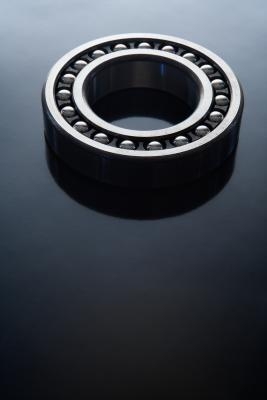
Ball and roller bearing help shafts and other parts rotate in vehicle components, motors and other equipment or machinery. They prevent direct contact between moving and non-moving components for easier operation, reducing stress and accelerated wear. Still, these bearings are subject themselves to a lot of stress, depending on the equipment they operate. As part of a maintenance schedule according to the manufacturer specifications, check them periodically for wear to prevent equipment damage.
Turn on and operate the piece of equipment with the bearing you want to inspect, if the bearing is accessible. Bearings on air conditioner motors, blowers and similar equipment, for example, are accessible by removing a lid or cover. Use a Phillips screwdriver to remove the cover if necessary.
Contact the bearing housing with the tip of a mechanic's stethoscope, and listen for noise. Keep the stethoscope hose away from moving parts. Check at various points around the piece of equipment to ensure the noise is coming from the bearing, which will be the loudest point. If the bearing is making a noise, add the proper lubricant to the bearing, if possible, and test for noise again. If the noise remains, replace the bearing.
Turn off power to the piece of equipment with the suspected bearing, and remove any components such as covers or belts, if necessary, to gain access to the shaft or part with the bearing. On vehicles, for example, you can inspect a wheel bearing by raising the wheel/tire assembly off the ground using a floor jack and securing the vehicle with a jack stand under the frame.
Put on your mechanic's stethoscope, and manually rotate the shaft or wheel/tire assembly with the bearing you want to inspect while listening for noise. Check at various points near the bearing to ensure the noise is loudest in the bearing housing. If possible, lubricate the bearing according to the manufacturer's instructions. If the bearing is still noisy, replace it.
Remove the ball or roller bearing from the piece of equipment, if possible, after listening for bearing noises with your mechanic's stethoscope. Follow the instructions on the equipment's service manual to remove the bearing safely.
Wash the bearing in solvent, and let it air dry for a few minutes.
Inspect each ball or roller visually for pitting, chipping, rust and wear spots. Check the bearing cage or roller housing for bents or cracks. Manually rotate the bearing next to your ear, and listen for noises. If you detect any minor damage, wear spots or noises, replace the bearing.
Check the bearing race as well if your piece of equipment is equipped with it. (The race is the outside steel ring where the bearing rotates as the machinery or equipment operates.) Inspect the race for hard posts, cracks, wear spots or any other indication of damage. If the race is damaged or worn out, replace both the race and the bearing.
Lubricate or pack the bearing with grease according to the manufacturer's instructions and reinstall the bearing if necessary.